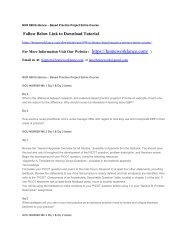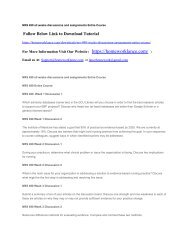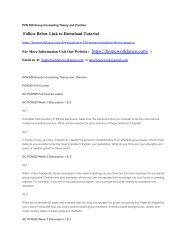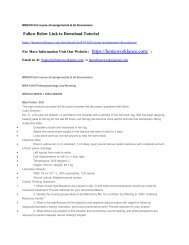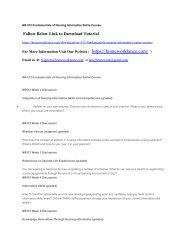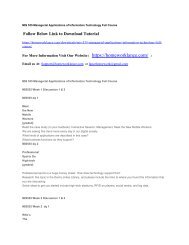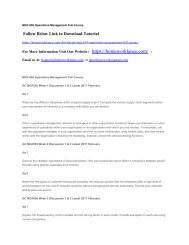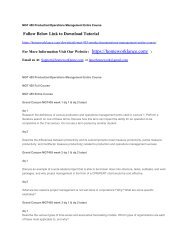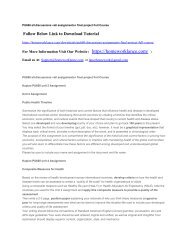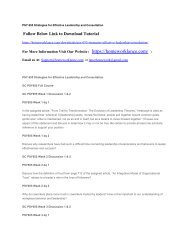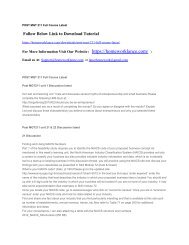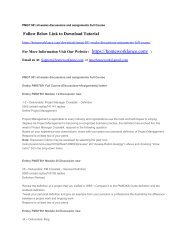PCN 509 Social and Cultural Diversity Issues in Counseling
Create successful ePaper yourself
Turn your PDF publications into a flip-book with our unique Google optimized e-Paper software.
<strong>PCN</strong> <strong>509</strong> <strong>Social</strong> <strong>and</strong> <strong>Cultural</strong> <strong>Diversity</strong> <strong>Issues</strong> <strong>in</strong> Counsel<strong>in</strong>g<br />
Follow Below L<strong>in</strong>k to Download Tutorial<br />
https://homeworklance.com/downloads/pcn-<strong>509</strong>-social-cultural-diversity-issues-counsel<strong>in</strong>g/<br />
For More Information Visit Our Website ( https://homeworklance.com/ )<br />
Email us At: Support@homeworklance.com or lancehomework@gmail.com<br />
<strong>PCN</strong> <strong>509</strong> <strong>Social</strong> <strong>and</strong> <strong>Cultural</strong> <strong>Diversity</strong> <strong>Issues</strong> <strong>in</strong> Counsel<strong>in</strong>g<br />
<strong>PCN</strong> <strong>509</strong> Full Course<br />
<strong>PCN</strong><strong>509</strong> Week 1 Discussion 1 & 2<br />
dq 1<br />
When <strong>and</strong> how did you become aware of people be<strong>in</strong>g treated differently because of race, culture, or religion?<br />
Expla<strong>in</strong><br />
dq 2<br />
The textbook uses the term “persons of color” What is your reaction to this? Why do you th<strong>in</strong>k the author uses this<br />
term? Support your answer with at least one scholarly reference<br />
<strong>PCN</strong><strong>509</strong> Week 2 Discussion 1 & 2<br />
dq 1<br />
How can a counselor with Christian beliefs demonstrate the golden rule when work<strong>in</strong>g with clients who have diverse<br />
worldviews?<br />
dq 2<br />
Are the major counsel<strong>in</strong>g theories culture-bound? Expla<strong>in</strong><br />
<strong>PCN</strong><strong>509</strong> Week 3 Discussion 1 & 2<br />
dq 1<br />
Why do people tend to deny, rationalize, <strong>and</strong> avoid discuss<strong>in</strong>g their feel<strong>in</strong>gs <strong>and</strong> beliefs about race <strong>and</strong> ethnicity?<br />
dq 2
Historically, racism <strong>and</strong> issues associated with it have been resistant to change State some reasons for the<br />
resistance<br />
<strong>PCN</strong><strong>509</strong> Week 4 Discussion 1 & 2<br />
dq 1<br />
What steps can the professional or addiction counselor take to set clients at ease <strong>in</strong> a manner that has mean<strong>in</strong>g to<br />
them? Give examples of such steps for three different ethnic groups<br />
dq 2<br />
What is the best first step to take when beg<strong>in</strong>n<strong>in</strong>g to work with a client struggl<strong>in</strong>g with substance use? What are some<br />
cultural considerations to keep <strong>in</strong> m<strong>in</strong>d? Expla<strong>in</strong> your rationale<br />
<strong>PCN</strong><strong>509</strong> Week 5 Discussion 1 & 2<br />
dq 1<br />
What are the dom<strong>in</strong>ant cultural features found with<strong>in</strong> Native American homes, <strong>and</strong> how do Native Americans shape<br />
their response to the broader American society?<br />
dq 2<br />
How is substance use viewed <strong>in</strong> the Hispanic/Lat<strong>in</strong>o culture?<br />
<strong>PCN</strong><strong>509</strong> Week 6 Discussion 1 & 2<br />
dq 1<br />
How do early personal experiences <strong>in</strong>fluence the positive or negative ethnic identity of persons of color? Can you<br />
th<strong>in</strong>k of a best example? Provide a scholarly reference to support your response<br />
dq 2<br />
What family <strong>and</strong> community support conditions must be <strong>in</strong> place to assist children of color from be<strong>in</strong>g at risk for low<br />
self-concept as a result of racism? Provide a scholarly reference to support your response<br />
<strong>PCN</strong><strong>509</strong> Week 7 Discussion 1 & 2<br />
dq 1<br />
How do racial, social, political, <strong>and</strong> religious attitudes affect the counselor’s perception <strong>and</strong> treatment of clients? How<br />
could the Christian worldview/chosen religious beliefs help with provid<strong>in</strong>g treatment to diverse populations?<br />
dq 2<br />
Expla<strong>in</strong> how mental health <strong>and</strong> addiction therapy are viewed <strong>in</strong> various cultures Give at least two examples
<strong>PCN</strong><strong>509</strong> Week 8 Discussion 1 & 2<br />
dq 1<br />
How should a culturally competent counselor approach the processes of assessment <strong>and</strong> diagnosis when deal<strong>in</strong>g<br />
with clients from m<strong>in</strong>ority client populations? Support your answer with at least one scholarly reference<br />
dq 2<br />
Provide an example of cultural bias <strong>in</strong> counsel<strong>in</strong>g/psychological research <strong>and</strong> support your answer with at least one<br />
scholarly reference<br />
<strong>PCN</strong><strong>509</strong> Week 1 Assignment<br />
Counsel<strong>in</strong>g Disposition Reflection Worksheet<br />
Directions:Review the dispositions document <strong>and</strong> select three dispositions that you currently meet <strong>and</strong> that have<br />
helped to be culturally competent Complete the chart by list<strong>in</strong>g the dispositions met as well as a description of how<br />
the disposition is met Each description response should be 75-100 words <strong>in</strong> length<br />
Dispositions Description<br />
Related to of how the<br />
<strong>Cultural</strong> disposition<br />
Competenceis met<br />
1<br />
2<br />
3<br />
Directions:Now that you have identified dispositions that you currently meet, review the disposition document aga<strong>in</strong><br />
<strong>and</strong> select two dispositionsrelated to cultural competence that may be areas of improvement Complete the chart<br />
below by add<strong>in</strong>g the two dispositions you do not meet as well as a prelim<strong>in</strong>ary plan <strong>in</strong> regards to how you plan to<br />
improve the identified dispositions Each description response should be 75-100 words <strong>in</strong> length<br />
Description<br />
of how you<br />
plan to<br />
Disposition<br />
improve<br />
the<br />
disposition<br />
1<br />
2<br />
<strong>PCN</strong><strong>509</strong> Week 2,4,6 & 8 Assignment<br />
Details:<br />
Refer to “<strong>Social</strong> <strong>and</strong> <strong>Cultural</strong> Paper Writ<strong>in</strong>g Instructions” for a detailed explanation of the requirements for the <strong>Social</strong><br />
<strong>and</strong> <strong>Cultural</strong> <strong>Diversity</strong> Paper that you will be develop<strong>in</strong>g throughout the course<br />
For this assignment, prepare a reference list that <strong>in</strong>cludes the sources you will be cit<strong>in</strong>g <strong>in</strong> the paper The paper must<br />
<strong>in</strong>clude a m<strong>in</strong>imum of 10 scholarly references <strong>in</strong> addition to the textbook More references may be used if necessary<br />
Prepare this assignment accord<strong>in</strong>g to the guidel<strong>in</strong>es found <strong>in</strong> the APA Style Guide, located <strong>in</strong> the Student Success<br />
Center An abstract is not required
You are not required to submit this assignment to Turnit<strong>in</strong><br />
<strong>Social</strong> <strong>and</strong> <strong>Cultural</strong> <strong>Diversity</strong> Paper Writ<strong>in</strong>g Instructions<br />
Overview<br />
The <strong>Social</strong> <strong>and</strong> <strong>Cultural</strong> <strong>Diversity</strong> Paper (1,750-2,000 words) requires the student to identify <strong>and</strong> reflect on possible<br />
personal biases regard<strong>in</strong>g gender, religion, sexual or gender orientation, race, socioeconomic status, disability status,<br />
or culture The purpose of this paper is to raise the student’s personal <strong>and</strong> professional level of awareness regard<strong>in</strong>g<br />
the subject of diverse populations<br />
Prepare this assignment accord<strong>in</strong>g to the APA guidel<strong>in</strong>es found <strong>in</strong> the APA Style Guide, located <strong>in</strong> the Student<br />
Success Center An abstract is not required<br />
This assignment uses a grad<strong>in</strong>g rubric Please review the rubric prior to beg<strong>in</strong>n<strong>in</strong>g the assignment to become familiar<br />
with the expectations for successful completion<br />
Process Schedule<br />
The <strong>Social</strong> <strong>and</strong> <strong>Cultural</strong> <strong>Diversity</strong> Paper assignment will be accomplished <strong>in</strong> a five-step process, with <strong>in</strong>dividual steps<br />
submitted <strong>and</strong> graded regularly throughout the course, accord<strong>in</strong>g to the follow<strong>in</strong>g schedule:<br />
1) Outl<strong>in</strong>e (Due Week 2)<br />
2) References (Due Week 4)<br />
3) First Draft (Due Week 6)<br />
4) F<strong>in</strong>al Paper (Due Week 8)<br />
Content Guidel<strong>in</strong>es<br />
When construct<strong>in</strong>g this paper, use a three-part structure accord<strong>in</strong>g to the follow<strong>in</strong>g guidel<strong>in</strong>es:<br />
Part 1<br />
The first part of the paper requires you to identify <strong>in</strong>formation from your own personal history Use the follow<strong>in</strong>g<br />
questions to help guide your reflections:<br />
1) Identify your personal biases <strong>and</strong> how they may be challenges to you as a therapist Remember, everyone has<br />
biases The po<strong>in</strong>t is not to project them onto your clients<br />
Note: It is preferred you discuss your cultural biases<br />
2) Describe your personal history by document<strong>in</strong>g experiences with discrim<strong>in</strong>ation you may have experienced <strong>and</strong><br />
how your cultural background impacted these experiences<br />
3) Identify memories of contact with those who were culturally different than you, <strong>and</strong> your experiences associated<br />
with these differences Be specific<br />
4) How has your life experience affected how you may relate to persons different than you? Be specific<br />
Part 2<br />
The second part of the paper requires you to demonstrate an underst<strong>and</strong><strong>in</strong>g of the concepts of racism/discrim<strong>in</strong>ation<br />
Use the follow<strong>in</strong>g questions to help guide your reflections:<br />
1) What does it mean to be a subtle racist? Please <strong>in</strong>clude a referenced def<strong>in</strong>ition <strong>and</strong> example<br />
2) Why could there be significant differences <strong>in</strong> perceptions <strong>and</strong> values of members with<strong>in</strong> the same ethnic group? Be<br />
specific<br />
Part 3<br />
The third part of your paper requires you to review <strong>and</strong> reflect on the ACA <strong>and</strong> NAADAC codes of ethics Use the<br />
follow<strong>in</strong>g to help guide your reflection:<br />
1) Discuss how the ACA <strong>and</strong> NAADAC codes of ethics will <strong>in</strong>form your practice<br />
1. a) Identify <strong>and</strong> cite the specific ACA <strong>and</strong> NAADA multicultural codes that you will use to <strong>in</strong>form your practice<br />
2) What did you learn about the importance of cultural sensitivity <strong>in</strong> treatment plann<strong>in</strong>g?<br />
3) How do communication styles differ across cultures?<br />
4) How might strategies to build rapport be differentiated based on culture?<br />
5) Exam<strong>in</strong>e underly<strong>in</strong>g reasons for differential treatment methods<br />
1. a) Consult several professional journals on treatment practices <strong>and</strong> cultural biases
2. b) Identify sources of potential counselor cultural bias with<strong>in</strong> these practices<br />
6) What resources could help you to become more <strong>in</strong>formed regard<strong>in</strong>g cultural diversity? Cite resources you can use<br />
to dispel yourpersonal biases<br />
7) How could you apply your learn<strong>in</strong>g to your future practice as a counselor?<br />
<strong>PCN</strong><strong>509</strong> Week 5 Assignment<br />
Details:<br />
Create an 8- to 10-slide PPT presentation discuss<strong>in</strong>g your cultural background (<strong>in</strong> addition, you should <strong>in</strong>clude a title<br />
slide <strong>and</strong> reference slide <strong>in</strong> your presentation) When discuss<strong>in</strong>g your culture, consider components of yourself such<br />
as race, ethnicity, religion, spiritual heritage, gender, sexual orientation, disabilities, socio-economic status, traditions,<br />
<strong>and</strong> family heritage You are not required to <strong>in</strong>clude any <strong>in</strong>formation you do not feel comfortable shar<strong>in</strong>g<br />
Include the follow<strong>in</strong>g <strong>in</strong> your presentation:<br />
1 Communication styles of your culture (verbal <strong>and</strong> nonverbal)<br />
2 Parts of your culture you are proud of<br />
3 Parts of your culture that you would like to improve<br />
4 Stereotypes toward your culture<br />
5 Stereotypes held with<strong>in</strong> your culture<br />
6 How your culture perceives substance use Are there any traditional uses of substances that are deemed culturally<br />
acceptable?<br />
7 How your culture perceives counsel<strong>in</strong>g<br />
8 How your cultural background will <strong>in</strong>fluence your ability to counsel someone from your culture <strong>and</strong> someone from<br />
another culture<br />
9 Speaker notes that <strong>in</strong>dicate what would be said if giv<strong>in</strong>g the presentation live<br />
APA format is required for any <strong>in</strong>formation not orig<strong>in</strong>ated by the student Include at least two scholarly references <strong>in</strong><br />
your presentation<br />
This assignment uses a rubric Please review the rubric prior to beg<strong>in</strong>n<strong>in</strong>g the assignment to become familiar with the<br />
expectations for successful completion<br />
<strong>PCN</strong><strong>509</strong> Week 7 Assignment<br />
Details:<br />
In a Word document, provide short answers to the statements below Refer to the “<strong>Cultural</strong> Considerations Resource”<br />
for help <strong>in</strong> complet<strong>in</strong>g this assignment<br />
Expla<strong>in</strong> cultural considerations that the counselor must account for when work<strong>in</strong>g with a client from each of the<br />
follow<strong>in</strong>g groups (100-150 words each):<br />
1 Immigrants (Documented <strong>and</strong> Undocumented)<br />
2 Refugees<br />
Discuss the cultural issues <strong>and</strong> trends that specifically apply to each of the follow<strong>in</strong>g regional population groups of the<br />
United States (100-150 words each):<br />
1 The Hmong <strong>in</strong> California<br />
2 Cuban Americans <strong>in</strong> Florida<br />
3 Hispanic Americans <strong>in</strong> the Southwest<br />
4 Your choice of a white ethnic group (eg, German, Irish, Italian)<br />
Prepare this assignment accord<strong>in</strong>g to the guidel<strong>in</strong>es found <strong>in</strong> the APA Style Guide, located <strong>in</strong> the Student Success<br />
Center An abstract is not required<br />
You are required to submit this assignment to Turnit<strong>in</strong> Please refer to the directions <strong>in</strong> the Student Success Center.



